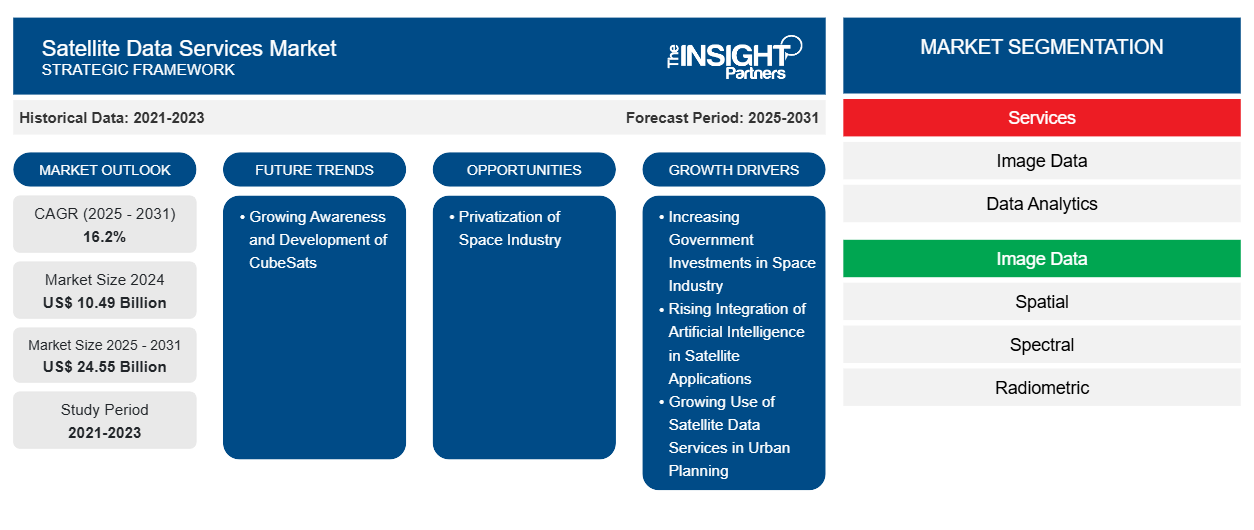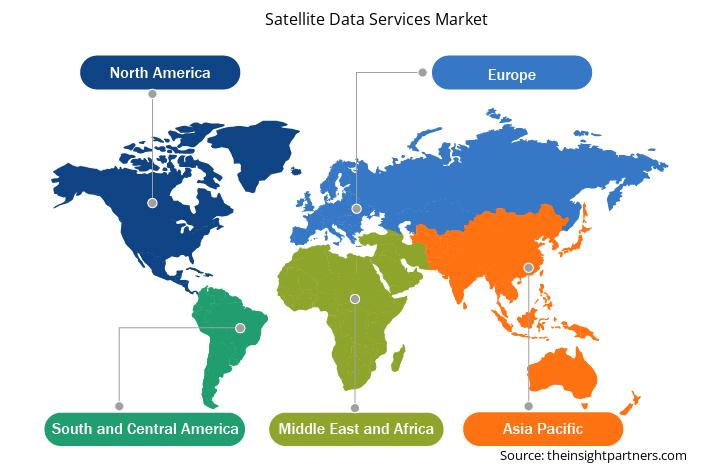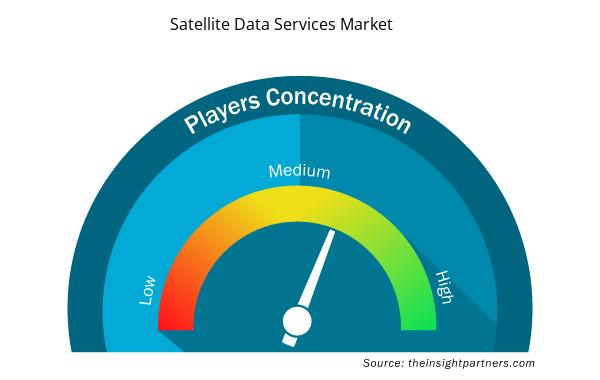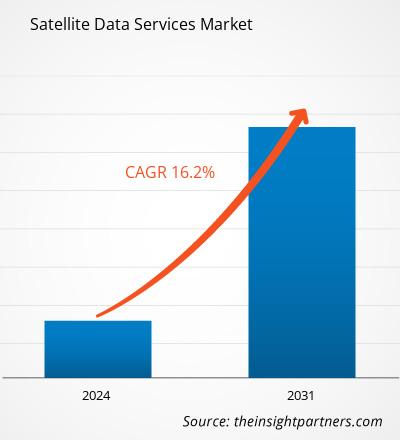2024 年卫星数据服务市场规模为 104.9 亿美元,预计到 2031 年将达到 245.5 亿美元;预计 2025-2031 年复合年增长率为 16.2%。立方体卫星的认知度和发展度不断提高可能仍是市场的主要趋势。
卫星数据服务市场分析
农业、国防、能源和电力以及采矿等众多行业的需求增长、政府对航天工业的投资以及技术创新是推动卫星数据服务市场发展的几个重要因素。此外,卫星数据服务在城市规划和农业监测中的日益广泛使用刺激了全球对卫星数据服务的需求。此外,航天工业的私有化以及用于教育目的和科学研究的小型卫星的发展是预计在预测期内为卫星数据服务市场增长创造机会的几个因素。此外,研发活动的增加、对高分辨率数据的认识不断提高以及纳米卫星的发展也促进了市场的增长。
卫星数据服务市场概况
卫星数据服务是基于云的服务,可访问光学和雷达 Sentinel-1 和 Sentinel-2 卫星的近实时分析卫星图像和衍生产品。这些服务用于收集、传输和分析来自绕地球运行的卫星的数据。卫星数据服务产品提供全天候情况下从雷达卫星收集的指标。政府或农业部门使用这些关键输入进行建模、监测、土地管理和政策制定。这些服务提供土地和水资源分析,为用户提供从田间到农场再到全国范围的农业和环境现状。此外,卫星数据服务支持农业和环境部门分析历史指标并从卫星指数(如自然资源管理、作物产量和风险管理)中识别趋势。此外,不断增长的遥感需求、对环境监测的关注以及精准农业和城市规划的扩展是推动卫星数据服务需求的几个因素。
定制此报告以满足您的需求
您可以免费定制任何报告,包括本报告的部分内容、国家级分析、Excel 数据包,以及为初创企业和大学提供优惠和折扣
卫星数据服务市场:

- 获取此报告的关键市场趋势。这个免费样品将包括数据分析,从市场趋势到估计和预测。
卫星数据服务市场驱动因素和机遇
增加政府对航天工业的投资
全球各国政府正越来越多地向航天工业投入大量资金,以扩大基础设施建设、太空探索和卫星技术。这些投资使卫星机构能够发射和维护先进的卫星,这些卫星为电信、国防、农业和环境等部门提供关键数据。随着各国政府将国家安全、技术进步和气候研究的太空计划列为优先事项,对高质量卫星数据服务的需求也在增长。这些数据用于地球观测,为气候、天气、城市化、农业和环境监测提供了重要见解。对于旨在研究地球或跟踪地球系统变化的太空任务来说,它至关重要。例如,2024 年 9 月,美国商务部与美国国家海洋和大气管理局 (NOAA) 合作,投资 110 万美元用于增强阿拉斯加洪水和冰塞事件中使用的卫星监测系统。这笔投资是阿拉斯加 227 万美元洪水监测项目的很大一部分。卫星监测系统的进步和发展使企业和政府能够获取与飓风、野火、洪水和其他偏远或难以到达的地区相关的实时数据。此外,政府不断增加的投资和资金;各行各业对卫星技术的高度依赖,为气候研究、灾害管理和资源管理提供实用信息;以及航天工业对卫星数据服务的高需求,推动了卫星数据服务市场的发展。
人工智能与卫星应用的融合
人工智能 (AI) 技术取得了显著进展,并继续证明其作为科学研究和实际应用基础的重要性。人工智能通过改进数据处理、分析和解释,为卫星数据服务市场的增长做出了重大贡献。卫星数据包括大量高分辨率照片和来自轨道的传感器数据。这些数据可轻松用于做出有效决策,并由人工智能和机器学习等先进技术进行管理。人工智能特别包括机器学习和深度学习算法,有助于自动化和加速这些庞大数据集的处理,从而更快速、更准确地提取可操作的见解。例如,人工智能技术能够很好地检测卫星图像中的模式,用于农业产量预测、气候监测、城市规划和灾害响应等众多应用。对管理庞大卫星数据的需求日益增长,鼓励市场参与者开发和集成人工智能到卫星应用中,以实现有效的数据管理。因此,人工智能和卫星数据服务的结合提高了性能,降低了成本,并为农业、电信、国防和环境监测等行业开辟了新的增长潜力。
卫星数据服务市场报告细分分析
有助于得出卫星数据服务市场分析的关键部分是服务和最终用户垂直市场。
- 就类型而言,卫星数据服务市场分为图像数据和数据分析。图像数据部分在 2024 年占据了更大的市场份额。图像数据部分分为空间、光谱、辐射和时间。数据分析部分细分为图像数据处理、数字模型、特征提取和分类。
- 根据最终用户垂直领域,卫星数据服务市场分为能源和电力、国防和安全、工程和基础设施、保险、环境、采矿、农业等。国防和安全部门在 2024 年占据了最大的市场份额。
卫星数据服务市场份额(按地区)分析
- 卫星数据服务市场分为五大区域:北美、欧洲、亚太地区 (APAC)、中东和非洲 (MEA) 以及南美和中美。2024 年,北美占据市场主导地位,其次是亚太地区和欧洲。
- 北美。低地球轨道 (LEO) 和中地球轨道 (MEO) 星座等先进卫星技术的发展显著提高了卫星互联网和数据服务的速度、覆盖范围和可靠性。此类产品的发展使卫星数据服务对北美各地的消费者和企业都更具吸引力。市场参与者之间的合作在扩大卫星能力和提供专业服务方面发挥着至关重要的作用,进一步推动了北美对卫星数据服务的需求。此外,卫星行业的扩张也促进了市场的增长。根据卫星行业协会 (SIA) 第 27 份年度卫星行业状况报告,2023 年,美国商业卫星行业发射了创纪录的 2,781 颗卫星,比上一年增长了 20%。
卫星数据服务市场区域洞察
Insight Partners 的分析师已详尽解释了预测期内影响卫星数据服务市场的区域趋势和因素。本节还讨论了北美洲、欧洲、亚太地区、中东和非洲以及南美洲和中美洲的卫星数据服务市场细分和地理位置。

- 获取卫星数据服务市场的区域特定数据
卫星数据服务市场报告范围
| 报告属性 | 细节 |
|---|---|
| 2024 年的市场规模 | 104.9亿美元 |
| 2031 年市场规模 | 245.5亿美元 |
| 全球复合年增长率(2025 - 2031) | 16.2% |
| 史料 | 2021-2023 |
| 预测期 | 2025-2031 |
| 涵盖的领域 | 按服务
|
| 覆盖地区和国家 | 北美
|
| 市场领导者和主要公司简介 |
|
卫星数据服务市场参与者密度:了解其对业务动态的影响
卫星数据服务市场正在快速增长,这得益于终端用户需求的不断增长,而这些需求又源于消费者偏好的不断变化、技术进步以及对产品优势的认识不断提高等因素。随着需求的增加,企业正在扩大其产品范围,进行创新以满足消费者的需求,并利用新兴趋势,从而进一步推动市场增长。
市场参与者密度是指在特定市场或行业内运营的企业或公司的分布情况。它表明在给定市场空间中,相对于其规模或总市场价值,有多少竞争对手(市场参与者)存在。
在卫星数据服务市场运营的主要公司有:
- 空中客车公司
- Maxar 科技控股公司
- L3Harris技术公司
- ICEYE 公司
- 图像卫星国际(ISI)有限公司
- LAND INFO 全球测绘有限责任公司
免责声明:上面列出的公司没有按照任何特定顺序排列。

- 获取卫星数据服务市场顶级关键参与者概览
卫星数据服务市场新闻和最新发展
卫星数据服务市场通过收集一手和二手研究后的定性和定量数据进行评估,其中包括重要的公司出版物、协会数据和数据库。卫星数据服务市场的一些发展情况如下:
- 空中客车制造的两颗新一代西班牙卫星中的第一颗西班牙卫星 NG-I 已成功搭载猎鹰 9 号火箭从美国卡纳维拉尔角发射。(来源:空中客车,新闻稿,2025 年 1 月)
- Maxar Intelligence 是一家提供安全、精确地理空间洞察的供应商,该公司证实其第五颗和第六颗 WorldView Legion 卫星在佛罗里达州肯尼迪航天中心通过 SpaceX Falcon 9 火箭发射到中倾角轨道后运行良好。此次成功发射后,Maxar 现在拥有七颗在轨卫星,能够收集 30 厘米级图像,这代表着超高分辨率图像容量的显著提升,标志着地理空间行业进入新时代。一旦所有六颗 WorldView Legion 卫星全面投入运营,Maxar 卫星群每天将能够收集超过 600 万平方公里的地球图像,其中包括多达 360 万平方公里的 30 厘米级图像。
(来源:Maxar Technologies,新闻稿,2025 年 2 月)
卫星数据服务市场报告范围和交付成果
“卫星数据服务市场规模和预测(2021-2031 年)”对市场进行了详细分析,涵盖以下领域:
- 卫星数据服务市场规模及全球、区域和国家层面所有主要细分市场的预测
- 卫星数据服务市场趋势,以及驱动因素、限制因素和关键机遇等市场动态
- 详细的 PEST 和 SWOT 分析
- 卫星数据服务市场分析涵盖主要市场趋势、全球和区域框架、主要参与者、法规和最新市场发展
- 行业格局和竞争分析,涵盖市场集中度、热图分析、知名参与者以及卫星数据服务市场的最新发展
- 详细的公司简介
- 历史分析(2 年)、基准年、预测(7 年)及复合年增长率
- PEST 和 SWOT 分析
- 市场规模价值/数量 - 全球、区域、国家
- 行业和竞争格局
- Excel 数据集



Report Coverage
Revenue forecast, Company Analysis, Industry landscape, Growth factors, and Trends

Segment Covered
This text is related
to segments covered.

Regional Scope
North America, Europe, Asia Pacific, Middle East & Africa, South & Central America

Country Scope
This text is related
to country scope.
常见问题
The global satellite data services market is expected to reach US$ 28.94 billion by 2031.
The key players holding majority shares in the global satellite data services market are Airbus SE; Maxtar Technologies; L3Harris Technologies Inc.; ICEYE Oy; and Planet Labs, Inc.
Growing awareness and development of CubeSats is anticipated to play a significant role in the global satellite data services market in the coming years.
The global satellite data services market was estimated to be US$ 10.48 billion in 2024 and is expected to grow at a CAGR of 16.2% during the forecast period 2025 – 2031.
Increasing government investments in space industry, rising integration of artificial intelligence in satellite applications, and growing use of satellite data services in urban planning are the major factors that propel the global satellite data services market.
The incremental growth expected to be recorded for the global satellite data services market during the forecast period is US$ 18.46 billion.
Trends and growth analysis reports related to Electronics and Semiconductor : READ MORE..
The List of Companies - Satellite Data Services Market
- Airbus SE
- Maxar Technologies Holdings Inc
- L3Harris Technologies Inc
- ICEYE Oy
- Imagesat International (I.S.I) Ltd.
- LAND INFO Worldwide Mapping, LLC
- Planet Labs PBC
- Satellite Imaging Corp
- SATPALDA
- Ursa Space Systems Inc
- Earth-i Ltd
- Ceinsys Tech Ltd
The Insight Partners performs research in 4 major stages: Data Collection & Secondary Research, Primary Research, Data Analysis and Data Triangulation & Final Review.
- Data Collection and Secondary Research:
As a market research and consulting firm operating from a decade, we have published and advised several client across the globe. First step for any study will start with an assessment of currently available data and insights from existing reports. Further, historical and current market information is collected from Investor Presentations, Annual Reports, SEC Filings, etc., and other information related to company’s performance and market positioning are gathered from Paid Databases (Factiva, Hoovers, and Reuters) and various other publications available in public domain.
Several associations trade associates, technical forums, institutes, societies and organization are accessed to gain technical as well as market related insights through their publications such as research papers, blogs and press releases related to the studies are referred to get cues about the market. Further, white papers, journals, magazines, and other news articles published in last 3 years are scrutinized and analyzed to understand the current market trends.
- Primary Research:
The primarily interview analysis comprise of data obtained from industry participants interview and answers to survey questions gathered by in-house primary team.
For primary research, interviews are conducted with industry experts/CEOs/Marketing Managers/VPs/Subject Matter Experts from both demand and supply side to get a 360-degree view of the market. The primary team conducts several interviews based on the complexity of the markets to understand the various market trends and dynamics which makes research more credible and precise.
A typical research interview fulfils the following functions:
- Provides first-hand information on the market size, market trends, growth trends, competitive landscape, and outlook
- Validates and strengthens in-house secondary research findings
- Develops the analysis team’s expertise and market understanding
Primary research involves email interactions and telephone interviews for each market, category, segment, and sub-segment across geographies. The participants who typically take part in such a process include, but are not limited to:
- Industry participants: VPs, business development managers, market intelligence managers and national sales managers
- Outside experts: Valuation experts, research analysts and key opinion leaders specializing in the electronics and semiconductor industry.
Below is the breakup of our primary respondents by company, designation, and region:

Once we receive the confirmation from primary research sources or primary respondents, we finalize the base year market estimation and forecast the data as per the macroeconomic and microeconomic factors assessed during data collection.
- Data Analysis:
Once data is validated through both secondary as well as primary respondents, we finalize the market estimations by hypothesis formulation and factor analysis at regional and country level.
- Macro-Economic Factor Analysis:
We analyse macroeconomic indicators such the gross domestic product (GDP), increase in the demand for goods and services across industries, technological advancement, regional economic growth, governmental policies, the influence of COVID-19, PEST analysis, and other aspects. This analysis aids in setting benchmarks for various nations/regions and approximating market splits. Additionally, the general trend of the aforementioned components aid in determining the market's development possibilities.
- Country Level Data:
Various factors that are especially aligned to the country are taken into account to determine the market size for a certain area and country, including the presence of vendors, such as headquarters and offices, the country's GDP, demand patterns, and industry growth. To comprehend the market dynamics for the nation, a number of growth variables, inhibitors, application areas, and current market trends are researched. The aforementioned elements aid in determining the country's overall market's growth potential.
- Company Profile:
The “Table of Contents” is formulated by listing and analyzing more than 25 - 30 companies operating in the market ecosystem across geographies. However, we profile only 10 companies as a standard practice in our syndicate reports. These 10 companies comprise leading, emerging, and regional players. Nonetheless, our analysis is not restricted to the 10 listed companies, we also analyze other companies present in the market to develop a holistic view and understand the prevailing trends. The “Company Profiles” section in the report covers key facts, business description, products & services, financial information, SWOT analysis, and key developments. The financial information presented is extracted from the annual reports and official documents of the publicly listed companies. Upon collecting the information for the sections of respective companies, we verify them via various primary sources and then compile the data in respective company profiles. The company level information helps us in deriving the base number as well as in forecasting the market size.
- Developing Base Number:
Aggregation of sales statistics (2020-2022) and macro-economic factor, and other secondary and primary research insights are utilized to arrive at base number and related market shares for 2022. The data gaps are identified in this step and relevant market data is analyzed, collected from paid primary interviews or databases. On finalizing the base year market size, forecasts are developed on the basis of macro-economic, industry and market growth factors and company level analysis.
- Data Triangulation and Final Review:
The market findings and base year market size calculations are validated from supply as well as demand side. Demand side validations are based on macro-economic factor analysis and benchmarks for respective regions and countries. In case of supply side validations, revenues of major companies are estimated (in case not available) based on industry benchmark, approximate number of employees, product portfolio, and primary interviews revenues are gathered. Further revenue from target product/service segment is assessed to avoid overshooting of market statistics. In case of heavy deviations between supply and demand side values, all thes steps are repeated to achieve synchronization.
We follow an iterative model, wherein we share our research findings with Subject Matter Experts (SME’s) and Key Opinion Leaders (KOLs) until consensus view of the market is not formulated – this model negates any drastic deviation in the opinions of experts. Only validated and universally acceptable research findings are quoted in our reports.
We have important check points that we use to validate our research findings – which we call – data triangulation, where we validate the information, we generate from secondary sources with primary interviews and then we re-validate with our internal data bases and Subject matter experts. This comprehensive model enables us to deliver high quality, reliable data in shortest possible time.

 获取此报告的免费样本
获取此报告的免费样本